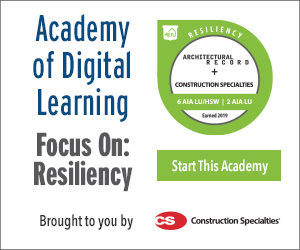Building Resiliency
 1.25 AIA LU/HSW; 0.1 IACET CEU*; 1 AIBD P-CE; AAA 1 Structured Learning Hour; This course can be self-reported to the AANB, as per their CE Guidelines; AAPEI 1 Structured Learning Hour; This course can be self-reported to the AIBC, as per their CE Guidelines.; MAA 1 Structured Learning Hour; This course can be self-reported to the NLAA.; This course can be self-reported to the NSAA; NWTAA 1 Structured Learning Hour; OAA 1 Learning Hour; SAA 1 Hour of Core Learning
1.25 AIA LU/HSW; 0.1 IACET CEU*; 1 AIBD P-CE; AAA 1 Structured Learning Hour; This course can be self-reported to the AANB, as per their CE Guidelines; AAPEI 1 Structured Learning Hour; This course can be self-reported to the AIBC, as per their CE Guidelines.; MAA 1 Structured Learning Hour; This course can be self-reported to the NLAA.; This course can be self-reported to the NSAA; NWTAA 1 Structured Learning Hour; OAA 1 Learning Hour; SAA 1 Hour of Core Learning
Learning Objectives:
- List key natural and man-made disasters that affect the built environment.
- Define resilient design and how it benefits cities, communities, and the economy.
- Discuss how designing for resiliency can impact building design and improve occupant health, safety, and well-being.
- Describe the benefits of specifying products designed for resiliency.
- Explain how buildings can achieve a U.S. Resiliency Council (USRC) rating.
This course is part of the Resiliency Academy
Conclusion
It’s safe to say that extreme weather events and related natural disasters are concerns that need to be taken very seriously. Throughout the United States and the world, cities and communities have been devastated by the impacts of hurricanes, floods, fires, wind, and ice storms, along with other natural disasters such as tsunamis and earthquakes. As many communities struggle to rebuild and others wonder if they’re next, architects, engineers, and developers all have an important opportunity to ensure that the structures they design and build fully embrace resilient building techniques and use architectural products that can help them achieve resilient outcomes.
End Notes
1Robert D. Neihaus Inc. “Preliminary Impact Assessment: Montecito Mudslides.” March 2018. Web. 18 April 2019.
2Shapiro, Emily. “5 Natural Disasters That Devastated the US in 2018.” ABC News. 8 Dec. 2018. Web. 18 April 2019.
3“Billion-Dollar Weather and Climate Disasters: Table of Events.” National Oceanic and Atmospheric Administration. National Centers for Environmental Information. Web. 18 April 2019.
4Ibid.
5Brown, Stephen. “Business Continuity Planning: The Often Under Prioritized Responsibility.” International Facility Management Association. March 2016. Web. 18 April 2019.
6Gray, Bradford H. and Hebert, Kathy. “After Katrina: Hospitals in Hurricane Katrina. Challenges Facing Custodial Institutions in a Disaster.” The Urban Institute. July 2006. Web. 18 April 2019.
7“What Is Resilience?” Resilient Design Institute. Web. 18 April 2019.
8“What is Hazard Mitigation?” Federal Emergency Management Agency. Department of Homeland Security. Web. 18 April 2019.
9Ibid.
10“Understanding Your Building’s Performance in Disasters.” U.S. Resiliency Council. Web. 18 April 2019.
11Kelechava, Brad. “AMCA Lover Standards.” American National Standards Institute. 18 May 2017. Web. 18 April 2019.
12Penndorf, Jon. “Adapting Building Design to the Effects of Climate Change.” Urban Land Magazine. 10 Aug. 2018. Web. 18 April 2019.
13“RELi 2.0: Rating Guidelines for Resilient Design + Construction.” U.S. Green Building Council. December 2018. Web. 18 April 2019.
14“About Us: Our History.” Zuckerberg San Francisco General Hospital. Web. 18 April 2019.
Rebecca A. Pinkus, MTPW, MA, is a Toronto-based communication consultant, writer, editor, and historian of technology. She has been writing for the green build industry for several years, contributing to more than 40 continuing education courses and publications through Confluence Communications.
 |
Founded in 1948, Construction Specialties (CS) is a specialty building products manufacturer. CS provides solutions to complex challenges architects, designers, building owners, facility managers, and contractors face every day. Since inventing the first extruded louver, CS has become a global leader in interior wall protection, impact-resistant doors, entrance mats & grids, expansion joint covers, architectural louvers & grilles, sun controls, explosion & pressure relief vents, cubicle curtains & tracks and stairs, awnings & balconies. CS draws upon extensive expertise to design high-quality products—many of which are Cradle to Cradle Certified™ Products Program. For more information please visit: c-sgroup.com |









